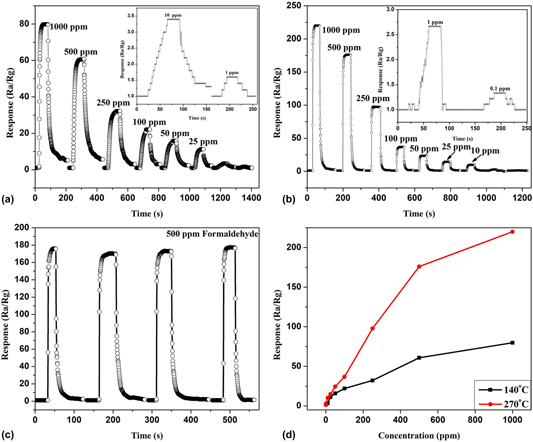Crossref Citations
This article has been cited by the following publications. This list is generated based on data provided by
Crossref.
Zhang, Jianxia
Li, Haiying
Li, Yu
Zhao, Bing
Ju, Xiangnan
Chen, Wenbin
Lu, Bingliang
Zeng, Xiangan
and
Liu, Li
2020.
A Eu3+-decorated α-Fe2O3 microflower composite film as a fast-response, low-temperature, and sensitive acetone sensor.
Journal of Materials Science: Materials in Electronics,
Vol. 31,
Issue. 3,
p.
2699.
Xu, Lei
Ge, Meiying
Zhang, Fang
Huang, Haijun
Sun, Yan
and
He, Dannong
2020.
Nanostructured of SnO2/NiO composite as a highly selective formaldehyde gas sensor.
Journal of Materials Research,
Vol. 35,
Issue. 22,
p.
3079.
Bhattacharya, Anish
Chu, Xiangfeng
Dong, Yongping
Liang, Shiming
and
Chakraborty, Amit K.
2020.
Influence of synthesis methods on the microstructure and Ethanol Sensing properties of barium stannate.
Vacuum,
Vol. 180,
Issue. ,
p.
109645.
Yang, Fuxiu
Zhang, Wenjuan
Wang, Hong
Gu, Chunxiu
Lu, Yun
and
Zhou, Kaowen
2020.
Determination of formaldehyde using a novel Pt-doped nano-sized sensitive material: Operating conditions optimization by response surface method.
Analytica Chimica Acta,
Vol. 1132,
Issue. ,
p.
47.
Nundy, Srijita
Eom, Tae-yil
Song, Kyung-Yoon
Park, Joon-Shik
and
Lee, Hoo-Jeong
2020.
Hydrothermal synthesis of mesoporous ZnO microspheres as NOX gas sensor materials — Calcination effects on microstructure and sensing performance.
Ceramics International,
Vol. 46,
Issue. 11,
p.
19354.
Bhattacharya, Anish
Zhang, Yin
Wu, Haiyan
Chu, Xiangfeng
Dong, Yongping
Liang, Shiming
Xu, Jiaqiang
and
Chakraborty, Amit K.
2020.
Ethanol sensor based on microrod-like La-doped barium stannate.
Journal of Materials Science: Materials in Electronics,
Vol. 31,
Issue. 20,
p.
17461.
Bhattacharya, Anish
Chu, Xiangfeng
Gao, Qi
Li, Xue
Dong, Yongping
Liang, Shiming
and
Chakraborty, Amit K.
2020.
Influence of Gd+3 incorporation on ethanol sensing properties of Barium Stannate microrod films prepared by coprecipitation method.
Applied Surface Science,
Vol. 504,
Issue. ,
p.
144289.
Adhikari, Arpita
Tiwary, Punam
Rana, Dipak
Halder, Arijit
Nath, Jyotisko
Basu, Arijita
Ghoshal, Debojyoti
Kar, Pradip
Chakraborty, Amit Kumar
and
Chattopadhyay, Dipankar
2020.
Na-cholate micelle mediated synthesis of polypyrrole nanoribbons for ethanol sensing.
Journal of Environmental Chemical Engineering,
Vol. 8,
Issue. 5,
p.
104249.
Priya, Pikee
and
Aluru, N. R.
2021.
Accelerated design and discovery of perovskites with high conductivity for energy applications through machine learning.
npj Computational Materials,
Vol. 7,
Issue. 1,
Manjunath, G.
Vardhan, Robbi Vivek
Praveen, Lakkimsetti Lakshmi
Nagaraju, P.
and
Mandal, Saumen
2021.
Room-temperature detection of ammonia and formaldehyde gases by LaxBa1−xSnO3−δ (x = 0 and 0.05) screen printed sensors: effect of ceria and ruthenate sensitization.
Applied Physics A,
Vol. 127,
Issue. 2,
Umm-e-Hani
Murtaza, Ghulam
AlObaid, Abeer A.
Al-Muhimeed, Tahani I.
Al-Qaisi, Samah
Rehman, Adeela
Hegazy, H.H.
Nazir, Ghazanfar
Morsi, Manal
and
Mahmood, Qasim
2021.
Tailoring of band gap to tune the optical and thermoelectric properties of Sr1-xBaxSnO3 stannates for clean energy; probed by DFT.
Chemical Physics,
Vol. 551,
Issue. ,
p.
111322.
Shihabudeen, P. K.
and
Roy Chaudhuri, Ayan
2021.
Ethanol sensing properties of nitrogen doped In2O3 thin films.
Journal of Materials Research,
Vol. 36,
Issue. 7,
p.
1561.
Tiwary, Punam
Chakrabarty, Nilanjan
Edwards, Holly J.
Dhanak, Vinod R.
Kar, Abhijit
Mahapatra, Rajat
and
Chakraborty, Amit K.
2021.
Hydrothermally grown uniform sized nickel hydroxide/oxyhydroxide hexagonal nanoprisms exhibiting room temperature ethanol sensing properties.
Applied Surface Science,
Vol. 570,
Issue. ,
p.
151090.
Balamurugan, Muthukutty
Alagumalai, Krishnapandi
Chen, Tse-Wei
Chen, Shen-Ming
Liu, Xiaoheng
and
Selvaganapathy, Muthusamy
2021.
Simultaneous electrochemical determination of nitrofurantoin and nifedipine with assistance of needle-shaped perovskite structure: barium stannate fabricated glassy carbon electrode.
Microchimica Acta,
Vol. 188,
Issue. 1,
Tiwary, Punam
Chatterjee, S.G.
Singha, S.S.
Mahapatra, Rajat
and
Chakraborty, Amit K.
2021.
Room temperature ethanol sensing by chemically reduced graphene oxide film.
FlatChem,
Vol. 30,
Issue. ,
p.
100317.
Chatterjee, Piyali
Ambati, Mounika Sai Krishna
Chakraborty, Amit K.
Chakrabortty, Sabyasachi
Biring, Sajal
Ramakrishna, Seeram
Wong, Terence Kin Shun
Kumar, Avishek
Lawaniya, Raghavendra
and
Dalapati, Goutam Kumar
2022.
Photovoltaic/photo-electrocatalysis integration for green hydrogen: A review.
Energy Conversion and Management,
Vol. 261,
Issue. ,
p.
115648.
John, Riya Alice B.
and
Ruban Kumar, A.
2023.
Tuning the p-type conductivity of NiO for the room temperature formaldehyde detection.
Inorganic Chemistry Communications,
Vol. 150,
Issue. ,
p.
110445.
Zhou, F. Y.
Xu, J. C.
Hong, B.
Peng, X. L.
Zeng, Y. X.
Li, J.
Ge, H. L.
and
Wang, X. Q.
2023.
Porous SnO2 nanospheres coated with reduced graphene oxide for formaldehyde gas sensor: Synthesis, performance and mechanism.
Journal of Materials Research,
Vol. 38,
Issue. 5,
p.
1266.
He, Shasha
Gui, Yingang
Wang, Yunfeng
and
Yang, Jiacheng
2023.
A self-powered β-Ni(OH)2/MXene based ethanol sensor driven by an enhanced triboelectric nanogenerator based on β-Ni(OH)2@PVDF at room temperature.
Nano Energy,
Vol. 107,
Issue. ,
p.
108132.
Marikutsa, Artem
Dobrovolskii, Andrey A.
Rumyantseva, Marina N.
Mikhaylov, Alexey A.
Medvedev, Alexander G.
Lev, Ovadia
and
Prikhodchenko, Petr V.
2023.
Improved H2S sensitivity of nanosized BaSnO3 obtained by hydrogen peroxide assisted sol-gel processing.
Journal of Alloys and Compounds,
Vol. 944,
Issue. ,
p.
169141.





